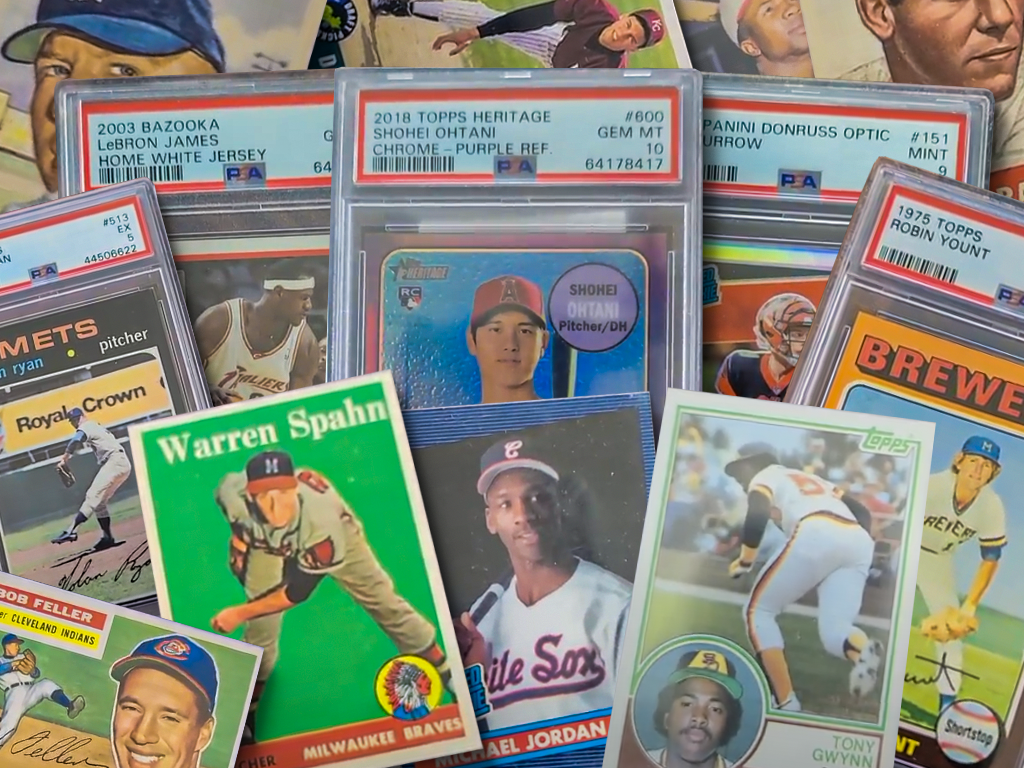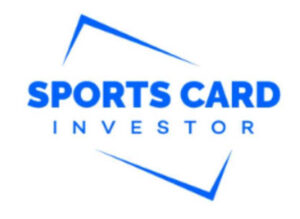
The Collector That Flips to Fund His 1 Million Card Collection
Chad Guell is a one-of-a-kind collector with experience in multiple facets of the sports card realm. From using cards for entertainment as a kid, to building his own kids’ collections of complete sealed sets, to flipping to fund his own massive PC, Guell has amassed over one million cards with some awesome stories accompanying his collecting journey.
Questions and answers were edited for length and clarity.
Tell us a little bit about yourself and your family
I’m from Wisconsin, I have a wife and four kids. My oldest son is 16 years old, and I’m kind of vicariously living my life through him right now. He’s a super athlete. He already has some Division-I schools looking at him for baseball, and Michigan has reached out to him to invite him to a camp. He’s a heck of a basketball and baseball player, so I’m currently really enjoying that. My daughter is 13, and I have a pair of 7 year old twins who are frequent contributors to the Sports Card Strategy Show & Tell series. They are always so proud to show off some of the cards in their collection, which definitely makes it fun.
When did you start collecting?
I got the bug when I was a child in the late 70’s. My dad would take me to the drug store, where they had 5-cent candy, and packs of cards that ranged from 25 cents to one dollar. My cousins who lived just a couple doors down were a few years older than me, and we created this game where you would set your lineup with every position from catcher to all three outfield positions and then for pitching we would pick out five cards (one starter and a couple of core relief pitchers).
We would flip the cards over and compare stats. For the non-pitchers, it was homeruns, whoever had the most home runs won. At the end of the game, whoever won got the other kid’s cards. That was how I started collecting. They were cards from the late 70s and were used cards that were meant to be played with. It wasn’t until the mid 80s when I started realizing that some of these cards could have value and I needed to stop playing with them. It wasn’t uncommon for me to spend $10-$15, and get some pretty nice cards. I did that right up until I graduated college. When I got out of college, I went off on other ventures and forgot about the cards. I kept them, but I wasn’t actively collecting anymore. I was out from 1995, until my son started showing interest in Pokemon cards from school. That was 2009, and it reinvigorated all of the love and passion I had for cards. From there, I started thinking, wouldn’t it be fun to create a run that wouldn’t stop? From the year I was born [1973] until now, I wanted a complete set of Topps baseball cards for every year.
So, I started going back and buying all of the years that I quit collecting. The only incomplete set from that run is a 1973 set, so I have 1974 to 2022 complete. Because I thought it was cool, I went back & started doing that for my kids. Harley-John [my oldest] has a complete sealed set of Topps baseball cards from 2006 to 2022, and he also has a complete set of Topps football sealed from 2006 to 2022. The twins got into cards as well, so they both have seven years of baseball and football complete sealed sets.
When did you start collecting football?
I collected football, basketball and baseball as a kid. I had the complete set of Topps 1980 basketball cards, which I then tore apart. When I was a child, it was fun. I’ve got them in a box but they aren’t in great shape from the games we played. Magic Johnson was my hero growing up. In every sport, I had to be No. 32 for Magic Johnson. That even carried over into church softball. I loved the Lakers of the 80s, they were awesome. It was the early 80s when I started collecting football and basketball cards, but I didn’t get serious about collecting for investment purposes until 2009.
Are you doing sealed sets for basketball, football, & basketball for them [the kids]?
I haven’t collected sealed basketball sets because they’re too hard to find. For the football and baseball cards, you’re able to go to Target to get a complete sealed set. I don’t think they’ll be especially collectable or worth anything. They don’t have a lot of value, but it’s just a way to get the kids hooked on it. Each of them has a binder of sleeves and pages they can take to school and trade cards. I never tell them what to do. I let them be themselves and that’s part of being kids. I learned and they have to learn.
How many total cards do you believe you have?
I don’t have an exact number, but I know my collection exceeds one million cards, based on my card boxes.
I did the math on all of the 5,000 full card boxes along with all of the complete sets, and that’s over a million in itself. That doesn’t even take into account all of the slabbed cards, or my cards in my safe that I feel are valuable. I know it’s a million plus, but what that number is, I don’t know. They’re not all valuable — I still have all of the cards I have from when I was a kid as sentimental.
Can you give the overview of how they’re separated & organized?
My wife routinely tells me I have too many cards. My grandfather came over from Germany on a boat, and I have a really cool storage container that he used on the boat to hold all of his life possessions. I have that full of complete sets stacked to the top. I thought it was cool, so I went and bought a replica [storage container] and filled that up with complete sets as well.
Then, I realized I still didn’t have enough room for complete sets, so I built more storage inside our walk-in closet.
My wife had all of her stuff in the back with mine in the front, and she got to a point where she was tired of stepping over cards so we had to flip-flop. She routinely reminds me she has 25% of this closest, and the other 75% are my clothes and cards. I’ve built shelves, I have boxes. I have sealed wax, I have binders and binders, as well as three safes (baseball, basketball, football). And then a final safe for high-end sealed wax cards. That’s all in my closet, irritating my wife on a daily basis. The floor of the closet is the stuff that I flip on a weekly basis to fund my PC.
My son no longer uses the dresser drawers because those are full of cards. He also has a closet with the right side, floor to ceiling, full of shelves of cards. The cards are all over the house, and it drives my wife nuts.
If a 0/10 is an episode of ‘Hoarders’, & a 10/10 is immaculately organized, where do you fall on the scale?
Probably an 8/10. For example, the local card shop called me up and said, “I’ve got a guy, he’s got a 1985 Topps set, but the only card he’s missing is the Kirby Puckett rookie, could you get me one?”
I’ve got multiple of those, so I went to the closet in the basement, which I have organized by year, and I pulled out some boxes to get to the 85s, and then they’re alphabetically ordered from there. It took me just 25 minutes to find him an ‘85 Kirby Puckett rookie card. They’re organized by year first, then player second.
If we were to do a pie chart of your collection, what percentage does each sport take up?
That’s a great question. I should know these numbers and I don’t. I would guess that I am 45% baseball, 25% basketball, 25% football. And then the last 5% is a smattering of hockey, soccer, tennis, Sports Illustrated Kids, tin cards, golf cards, swimming cards and celebrity cards. If it’s collectible and it’s a card, I was interested and I bought it.
From the late 70s to mid 80s, I collected like every other kid did. That was 50/50 baseball and football; at the time there was very little basketball. It was the mid 80s when I started to realize these things could be worth some money. I started to go to local card shows and flea markets with my dad and we would buy cards strictly for investment purposes. And then, a good friend of mine, Dan Kretchmer, who got me into soccer, owned a baseball card shop in Lake Geneva in the late 80s, early 90s. He’d have players come in for autograph signings and we’d get to go behind the scenes. That was always super cool. He sold his shop and moved to northern Illinois. He was the one that really got my dad into collecting.
But the ones that made everyone’s mouth water were the early Mantles, Hank Aarons, Ted Williams. That’s my dad’s baseball collection that he gave to me a few years ago when he got sick. Those are really special, that’s why I haven’t ever graded any of them. He really didn’t collect cards as a kid, but he bought several thousand dollars of cards from Dan Kretchmer aka ‘Kretch’ right before he sold his baseball card shop.
Was that a decision where you and your dad both knew that would be a good investment? What are some of the top cards from it?
Absolutely. Kretch told us, “I’ve got this collection, it’s $10,000. I know it’s a lot, but it’s worth way more”. He talked my Dad into buying it as an investment.
Some of the top cards include: 1953 Topps Mantle, 1953 Bowman Mantle, 1955 Koufax, 2nd-, 3rd-, and 4th-year Hank Aaron cards, Ted Williams and Willie Mays.
What year did he buy that collection, and what do you estimate the value at now?
Right around 1990, and between $50,000 and $60,000, raw condition. It depends on how they grade. The 1957 Bowman Mickey Mantle, I have never seen one in this condition raw, ever. I really think that could be a PSA 7 or a PSA 8. If they all graded out 4s and 5s, it could be worth over $100,000.
If there is one card in your collection that you think could be worth the most money, which one is it?
The 1955 Topps Sandy Kofax rookie. I would be shocked if it isn’t at least a PSA 6, and think it has a legitimate shot at a PSA 9. People often accuse it of being a reprint until they can smell the 1950’s cardboard. That card is absolutely astonishing in person.
Can you describe what year and why you started investing in sports cards yourself?
It was my son being born. I started wondering what type of investment I could do that would be fun for my kids, that we could do together.
I thought, rather than open up some Fidelity accounts, wouldn’t it be so much more fun if I could take them to card shows like I did with my dad?
I was fortunate enough that my first child loved cards. I did it because I love cards, I love the hobby, and I love spending time doing it. It’s exhilarating to buy a $10 card and turn it into a $15 card.
I used to think flippers were evil people, and then I started doing it and realized this is fun, I see what these people are all about. It’s just another way to enjoy the hobby. There’s so many different things you can do, that’s why I love the hobby. It’s not just dialed into one different age group or type of person, it’s for everybody.
When do you feel like your collection peaked in terms of volume?
In 2021, it spiked like everything else did. If I had any foresight at all, I would’ve sold my entire collection in 2021, semi-retired, and then bought them all back in 2023. But that was the sharp spike because of some insanely high prices. In terms of volume, I would say I went from a few hundred thousand cards to a million pretty quickly, in the last 10 years or so.
Have there ever been any times where you have questioned what you’re doing?
Everyday. My best friend has a son that graduated high school, and he had a fund setup for his son to go to college. While I was investing in cards, he was investing in his son’s future with financial responsibility. It makes me wonder if I did the right thing.
What year did you start flipping?
I started flipping in 2018. I did not sell a card out of my PC or otherwise until 2018. Which is how I have amassed so many cards since.
I currently do a segment on the Sports Card Strategy Show about how to flip to fund your PC.
You’ve become known as Dr. Crack and The Sports Card Doctor on that show, why?
Haha, yes! The community there is incredible. “Dr. Crack” come from my recommendations on which slabs to crack from certain grading companies and submit raw to others, in the interest of profit. The Sports Card Doctor or “Doc,” comes from the audience appreciating my answers to their questions, which is really fun for me. I love the NoOffseason.com family.
Can you break down the split of funds that you put back into your collection, versus money that you take out?
That’s a great question. Depends on the year. When I started flipping to fund my PC, it was 100% back into my collection. That was the sole purpose. I learned back in 2018, I can fund my personal collection for free because I can make enough money on what I was flipping to pay for what I wanted to keep.
I wasn’t very good at flipping in 2018, and I took more losses than profits. Over time you learn what you can and can’t do, so when I was asked to join the Sports Card Strategy Show and help others learn, I jumped at the opportunity because that’s what the hobby is all about — sharing stories and helping people collect what they love.
In 2022, with the rise of inflation, I would say it was probably closer to 50/50. Half paid the bills, half to fund the PC. Over the last 3 months, it’s back to 100% funding the PC again.
You have multiple streams of income, but from a personal family decision-making standpoint, what conversations have you had to have in relation to funds used?
I can tell you that when I first started trying to flip cards, I lost more than I made. I had to fund it with my job and sales career. I can tell you that it created some heartburn at times with my wife. We had many difficult decisions and discussions. There were times I either had to stop buying cards completely, or the conversation was, “you just got cards, why can’t we afford this?”
I quickly came to the conclusion that I needed to get really good at this if I didn’t want it to affect my family/relationship. It was in 2019 that I made the commitment to no longer inject any money into the cards that did not come from what I earned trading.
At that time, I had about $1,000 in bankroll that I was using, and I had to create enough income that I could keep it going. There was a point in 2020 when that bankroll was under $200.
I was going to get out of the card hobby because I promised my wife we wouldn’t inject more money into the cards. With the last $200, I was watching a YouTube video and thought, “gosh, that makes a lot of sense, why haven’t I tried that before?”
I took my last $200 and invested into a process that worked. Then, sports cards exploded and you couldn’t make a mistake during the pandemic, which certainly helped when you’re trying to do this to make money.
All of a sudden in 2021, I’ve got a $5,000-7,000 bankroll with cards. Sending out bi-weekly PSA submissions, able to spend $1,000 a month grading cards.
It just kept rolling and rolling to the point where my accountant last year told me that I needed more write-offs, because last year was such a good year with the sports card hobby.
With the Sports Card Investor app, you can profit from the hobby you love by keeping up with trending cards, tracking real-time prices with Market Movers and buying items on eBay. Download the industry-leading app here for Apple or Android.
Note to readers: If you purchase something through one of our affiliates, we may earn a commission.
Paul Hickey is a regular contributor to Sports Card Investor, the creator of the Sports Card Investment Report at NoOffseason.com, and the host of the Sports Card Strategy Show on Apple Podcasts, Spotify and YouTube. He can be found on Instagram at @sportscardstrategy and on Twitter @nooffseasoncard.






